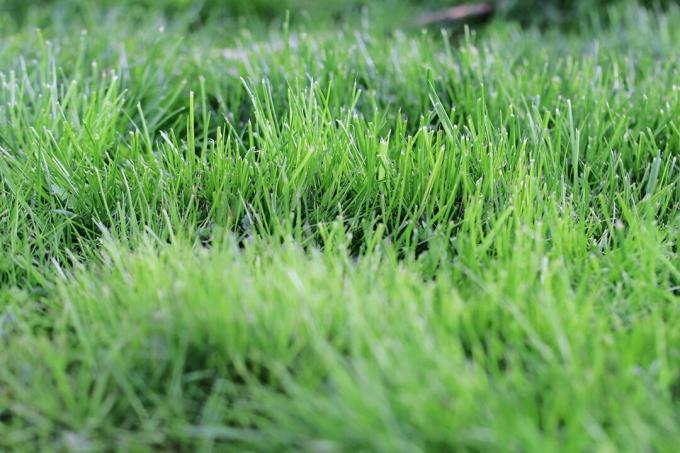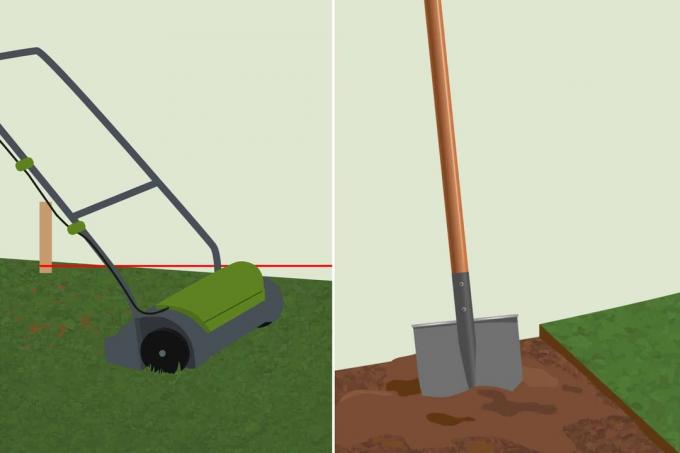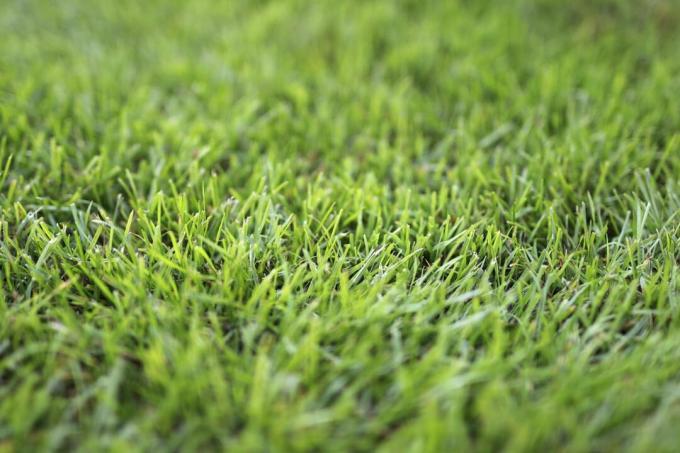

Table of contents
- Appropriate lawn cuttings
- Advantages
- areas in the garden
- time
- Instructions in seven steps
- Let dry
- remove weeds
- long-term fertilizer
- Thickness of the mulch layer
- distance in vegetable plants
- loosen up
- Re-deployment
- Special Mixtures
Lawn care includes regular mowing. A large amount of lawn clippings accumulate between spring and autumn. One use for the lawn clippings is to use them as mulch.
Appropriate lawn cuttings
At first glance, all lawn waste that occurs when mowing looks the same. However, if it is to be used for mulching, it is worth taking a closer look. Grass clippings that contain seed-bearing grasses and/or weeds are not suitable as mulch. Because the seeds germinate after they have been spread and have to be weeded again later.
Tip:
Since short blades of grass decompose more easily than long ones, you should choose a fine cut when mowing.
Advantages
The benefits of using lawn clippings as mulch are:
- protects the soil from drying out and wind erosion
- largely suppresses the growth of weeds
- rots into valuable humus
- forms a protection for the microorganisms living in the soil
- prevents crusting of the earth's surface
- is part of the natural cycle
areas in the garden
You can use the cut blades of grass as mulch in all areas of the garden, such as
- in the vegetable patch, especially fast-eating vegetables
- under trees
- under shrubs
- under hedges
In a perennial bed you should be careful with the mulching. Densely planted beds don't need mulch as the plants spread out and cover the soil surface. Equally counterproductive is spreading the lawn waste on perennial beds that prefer dry soil.

A notice:
Lawn waste is not suitable as mulch for loamy soil, as the risk of waterlogging increases.
time
Grass clippings can be used for mulching from spring through fall. The lawn waste from the first mowing passes is particularly suitable for the vegetable patch. However, you should only apply the material when the vegetable plants have reached a height of at least ten centimeters.
Instructions in seven steps
Follow the steps below and enjoy the fruits of your labor.
Let dry
It is controversial whether the grass clippings can be used directly from the lawnmower's collection container for mulching or whether they should first be dried slightly. The disadvantage of drying is that the material does not dry up as compactly and is therefore blown away by the wind. With freshly cut material, there is a risk that it will start to rot because it sticks together. The green also attracts snails.
Tip:
You can simply leave the cut blades of grass on the mown area to dry.
remove weeds
It is true that lawn clippings are a good protection against weeds. However, it only protects against new wild plants. Therefore, you should weed the bed before applying the mulch layer.
long-term fertilizer
The decomposition process of lawn clippings removes nitrogen from the soil. However, since this is essential for the growth of vegetable plants, some professional gardeners recommend applying an organic long-term fertilizer to the bed before mulching.
Thickness of the mulch layer
How high you apply the mulch layer depends on whether the material is fresh or slightly dried:
- fresh grass clippings: around eight to ten centimetres, quickly collapses in half as it dries
- Slightly dried grass clippings: about four to five centimetres
If the weather is rather damp when mowing or in the next few days, you should store fresh lawn clippings at a height of a maximum of two centimetres, since lawn clippings in which moisture accumulates can easily rot begins. In addition, it sticks together strongly, so that no oxygen penetrates to the ground.
distance in vegetable plants
Since there is a risk that the mulch layer will start to rot, especially in damp weather, you should not mulch two to three centimeters around the plant with the lawn waste.

loosen up
Although most of the grass clippings will rot after a few weeks, the rotting process can take longer in inclement weather. Therefore, you should always loosen the mulch layer slightly. This way you can also avoid that
- a mulch layer that has gotten a bit too thick compacts or
- Mice discover the grass clippings as a roost.
Re-deployment
When you can mulch with the lawn waste again depends on the rotting process. A prerequisite for spreading a new layer of mulch is that the old one has decomposed. This is usually the case after four to six weeks.
Special Mixtures
By adding other material to the lawn clippings, you can create special mixes for individual areas in the garden. In addition, the risk of the lawn waste starting to rot is reduced.
- Vegetable bed: mix cut grass with shredded vegetable waste (leaves, peels) and some coarse compost
- fruit-bearing shrubs: mix lawn waste with finely chopped hedge waste from spring trimmings and a little bark mulch
- Strawberry bed: mix grass clippings with some straw, apply shortly before harvest, strawberries stay dry
- Winter protection for the soil: mix lawn clippings with other chopped clippings and plant remains, apply thickly
 garden editorial
garden editorial I write about everything that interests me in my garden.
Learn more about lawn care

Leveling out unevenness in the lawn: this is how it works
Unevenness in the lawn is annoying and poses a danger to gardeners, playing children and pets. There are a number of methods that can be used to level the lawn. We present them to you in our guide.

Leveling the lawn: how to smooth uneven surfaces
Dents and holes in the lawn are unsightly. We will show you step by step how to smooth uneven areas in the lawn again.

Algae in the garden | Lawn is slippery: what to do?
Algae love rainy days. Can the water seep badly into the ground, even better! The green, slippery mass is not only not a pretty sight, but also a danger for the lawn. Only those who act preventively and correctly in acute cases can avoid permanent damage.

Fighting fungi in the lawn | 10 tips against fungal infestation
Mushrooms in the lawn are not uncommon but annoying and sometimes even dangerous. This is especially true if the garden or green space is also used by pets and children. Here we will show you how to combat fungal infestation.

Aerate the lawn | Before or after mowing?
Sun, water, fertilizer and air are necessary for the lawn to grow. If the lawn does not get enough air, it cannot grow properly. We clarify when the right time to ventilate the lawn is.

How much soil do I need per m²: Apply lawn soil
If an area in the garden is to be converted into a lawn, then it makes sense to distribute the appropriate soil as a substrate. This raises the question of how much lawn substrate is required per m² of area. It does not matter whether turf or sowing is used afterwards.


